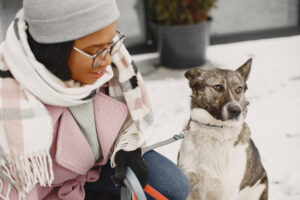To best understand this article in the context of the literature on growling, snarling, snapping, and biting behavior (incidence and correlates), please see National Canine Research Council’s complete analysis here.
National Canine Research Council Summary and Analysis:
The recent report by Matos et al. (2015) was an exploratory study meant to identify factors involved in canine warning and biting behaviors in the Slovak Republic. It is included here because of its similarity to a study conducted in the U.K. in 2014 (Casey et al., 2014), although the incidence rates found in this convenience sample responding to a questionnaire were dramatically higher than those in Casey et al. (2014), with a total of 67% of dogs reported by their owners as exhibiting at least one of the behaviors of interest, which included growling, lunging, snapping, and biting behaviors toward the owners or toward unfamiliar people. The results also showed that owner reports of fearfulness in their dogs was a strong predictor of these behaviors. However, the study did not include the questions put to the survey responders regarding how they determined that their dogs were afraid. Additionally, younger owners were more likely to have dogs who expressed these behaviors as were owners who reported using “informal ” rather than “formal” (terms undefined) training methods. Dogs who expressed these behaviors in multiple contexts were less likely to be neutered. Because this was a convenience sample there is no way to determine the extent to which the results could be extrapolated to the pet dog population as a whole, however they do serve as preliminary data to shape hypotheses for future research.
This study’s sampling method was similar to that of the 2014 report by Casey et al. Researchers first recruited participants at dog parks, dog shows, and a university veterinary department. From there, participants were acquired via the snowball sampling method; participants would recruit their friends and family members. Demographic and behavioral data were gathered about the dog, including size, age, training, breed, feeding routines, living conditions, behavior during play, grooming, and medicine administration, and obedience. Owner demographics were also recorded.
Of the 217 surveys collected, 177 (81.6 %) of participants answered all of the relevant questions, thus, only those 177 were included in the data analysis. Nearly 80% of participants were female and most were city-dwellers (61.6%). Most owners (88.6%) had trained their dog in some capacity. Nearly 70% of the dogs in this sample were small or medium and a larger proportion of females were spayed (20%) than males were neutered (8.5%).
The incidence findings were striking. Half of the responding owners reported that their dogs had growled at, lunged, snapped at, or bitten a familiar person at some time, 40% had directed these behaviors at unfamiliar people, and >11% were reported to have done so frequently toward unfamiliar people. The researchers found that both familiarity between dog and person, as well as the specific context, affected the probability of these behaviors. The approach of an unfamiliar male was the situation most likely to invoke these behaviors (33.3% of dogs) while physical punishment was the least likely. The relationship between fear and aggression was systematically explored in three series of five statistical models. In the first series the relationship was explored independent of familiarity then adjusted for owner demographics, canine demographics, housing, and training. In all models, fear was a strong predictor of all the behaviors of interest; fear behavior increased the probability of growling, lunging, snapping, and biting. The additional risk factors (owner age, dog’s reproductive status, and training method) had much smaller effects.
Despite the non-random convenience sample, the participants did include individuals from a range of environments. Moreover, the selection process made sense in the context of the region; Slovakia does not have behavior referral programs or recognized behavior specialists. The owners know their dogs best and observe them in a variety of contexts over long time spans, although it often requires very carefully framed questions to elicit the objective information sought in a study like this. Conversely, they may not be representative, particularly due to the self-selection bias implied by their willingness to participate in such a study. However, data on a wide variety of factors were included which helps paint a bigger, more detailed picture.





